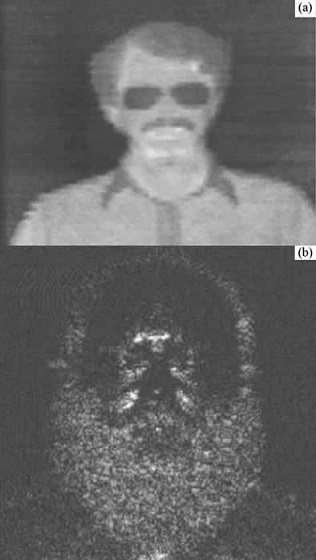Indoors and at High Frequency
With cooled bolometers that are both sensitive and which have larger optical bandwidth at higher frequencies, it is possible to build passive systems with good signal to noise. The upper panel of Figure: Indoor Image shows an image made with a cooled bolometer and several hundred GHz of bandwidth centered on 650 GHz [1]. This is a true passive image, taken indoors. It shows the differential temperature of the skin, as well as the colder glasses and hair. While this image shows the potential of passive imagers in the THz and interesting target phenomenology, it is not a practical system; being based on a 0.3 K bolometer (with an NEP ~4x10-15 W/Hz-1/2, which is near the fundamental limit) and a slow single point scanner.
Figure: Indoor Image. (a) An indoor image of a

face made with a passive bolometer system centered
on ~650 GHz and (b) an image of a face made with
an active illuminator and heterodyne receiver at 632
GHz.
Several more practical imagers take advantage of low noise amplifiers at 94 GHz and line scanners to increase the allowable frame rates and integration times for indoor imaging [2]. This approach seems particularly promising as these low noise amplifiers are extended to higher frequency [3]. which can provide larger bandwidths, better angular resolution, and the prospect of lower cost integration.
References
- Passive Imaging with a Broadband Cooled Detector 12th International Conference on Infrared and Millimeter Waves (1987). Google Scholar
- An Overview of Solid-State Integrated Circuit Amplifiers in the Submillimeter-Wave and THz Regime IEEE Trans. Terahertz Sci. Technol. 1, 9-24 (2011). Google Scholar
- THz Monolithic Integrated Circuits Using InP High Electron Mobility Transistors IEEE Trans. Terahertz Sci. Technol. 1, 25-33 (2011). Google Scholar